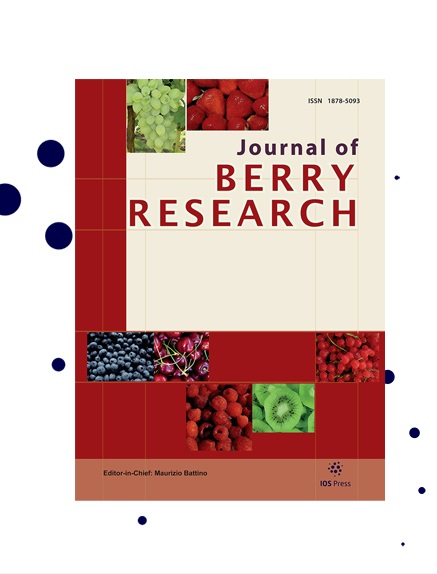不同干燥温度对蓝莓风味相关品质的影响
IF 1.4
4区 农林科学
Q3 PLANT SCIENCES
引用次数: 1
摘要
背景:蓝莓富含有机和无机化合物,如糖、蛋白质、多酚。但这种水果极易腐烂,难以储存和运输。目前,为了延长保质期,蓝莓经常被加工成各种各样的产品。例如,干燥是最常用的加工方法。然而,干燥过程对风味和品质的影响仍未被探索。目的:本研究采用50、60、70、80℃热风干燥蓝莓。研究了不同干燥温度对蓝莓风味物质和品质的影响,包括水分含量、颜色、还原糖和游离氨基酸。结果:随着干燥温度的升高,蓝莓干燥制品中的水分、还原糖和游离氨基酸含量显著降低(P < 0.05)。此外,50℃显著促进了蓝莓中游离氨基酸、芳樟醇和α-松油醇等关键风味成分的形成(P < 0.05)。此外,观察到最小的热损伤。在风味主成分分析中,50°C干燥的蓝莓样品在所有测试温度中最接近原料。因此,50℃较为适合蓝莓热风干燥和品质保持。结论:总体而言,本研究可以探索不同温度对蓝莓干制品品质的影响,为蓝莓未来的生产和产业化提供优化依据。本文章由计算机程序翻译,如有差异,请以英文原文为准。
Effects of different drying temperatures on flavor related quality of blueberry
BACKGROUND: Blueberries are rich in organic and inorganic compounds, such as sugars, proteins, polyphenols. But this fruit is highly perishable and difficult to store and transport. Currently, to increase their shelf life, blueberries are often processed into a variety of products. For example, drying is the most frequently processing method. However, the effect of the drying process on flavor and quality remains unexplored. OBJECTIVE: In this study, blueberries were hot air dried at 50, 60, 70, and 80°C. The effect of different drying temperatures on blueberries’ flavor substances and quality, including moisture content, color, reducing sugar, and free amino acids, were investigated. RESULTS: The results demonstrated a significant reduction in the moisture, reducing sugar, and free amino acid contents in dried blueberry products with the drying temperature(P < 0.05). In addition, 50°C significantly promoted the formation of free amino acids, linalool and, α-terpineol crucial flavor components present in blueberries (P < 0.05). Furthermore, minimum thermal damage was observed. In the flavor principal component analysis, the blueberry samples dried at 50°C were the closest to the raw material among all the temperatures tested. Therefore, 50 °C was more suitable for blueberries hot air drying and maintaining the high-quality. CONCLUSION: Overall, this study could explore the influence of different temperatures on the quality of blueberry-dried products and could help optimize the future production and industrialization of blueberries.
求助全文
通过发布文献求助,成功后即可免费获取论文全文。
去求助
来源期刊

Journal of Berry Research
Biochemistry, Genetics and Molecular Biology-Biochemistry
CiteScore
3.50
自引率
11.80%
发文量
21
期刊介绍:
The main objective of the Journal of Berry Research is to improve the knowledge about quality and production of berries to benefit health of the consumers and maintain profitable production using sustainable systems. The objective will be achieved by focusing on four main areas of research and development:
From genetics to variety evaluation
Nursery production systems and plant quality control
Plant physiology, biochemistry and molecular biology, as well as cultural management
Health for the consumer: components and factors affecting berries'' nutritional value
Specifically, the journal will cover berries (strawberry, raspberry, blackberry, blueberry, cranberry currants, etc.), as well as grapes and small soft fruit in general (e.g., kiwi fruit). It will publish research results covering all areas of plant breeding, including plant genetics, genomics, functional genomics, proteomics and metabolomics, plant physiology, plant pathology and plant development, as well as results dealing with the chemistry and biochemistry of bioactive compounds contained in such fruits and their possible role in human health. Contributions detailing possible pharmacological, medical or therapeutic use or dietary significance will be welcomed in addition to studies regarding biosafety issues of genetically modified plants.
 求助内容:
求助内容: 应助结果提醒方式:
应助结果提醒方式:


